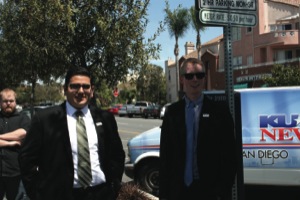
For many LGBT people – especially the guys – sun worshipping at Black’s Beach is as much a part of the Hillcrest scene as dancing at a club. But May is Skin Cancer Awareness Month and for those who don’t think skin cancer is serious, remember James Rebhorn, the character actor perhaps best known as Clare Danes’ father on Homeland, and who starred in a host of other movies including the gay favorite, White Squall. Rebhorn died in March after losing his two-decade long battle with skin cancer. Ewan McGregor, William H. Macy, Melanie Griffith, Brooke Shields and gay newscaster Anderson Cooper are among the many celebrities who have also had cancerous growths removed from their faces.
If there were a “whitest guy in Hillcrest” contest, it would likely come down to a tie between Tanner Songer and Micheal Murray; the judges for such an event would be well-advised to wear welders’ goggles to protect their eyes from the brightness.
Unlike many cancers which tend to hit later in life, skin cancer doesn’t practice age discrimination. Songer was only 28 when he noticed a patch of reddish, flakey skin on his neck. “It looked like a rash that didn’t go away,” he said. His self-diagnosis was that it was cancer; then he saw that Pomerado Hospital in Poway was doing a free screening. “I didn’t have health insurance at the time so I went up there. As soon as the dermatologist looked at it, he said, ‘I know exactly what that is and it’s definitely cancer.’” Now 30, Songer recently discovered another hard red spot that his doctor wants to biopsy, also suspecting it is a basal cell carcinoma. One advantage of the Affordable Care Act – Songer now has insurance. The $785 procedure will run him $20.
Murray, a former go-go boy at Rich’s, knows how much value is put on what he calls the “godly Southern California tan.” At 29, and well aware that his poz status leaves him more vulnerable to most cancers than those without HIV, he says that he no longer spends every day at the beach. “If I go, I pack on the sunscreen. I can’t come away looking like a tanned god anymore.” He hasn’t had any problems yet, but adds, “About eight months ago, I had a mole that changed colors so I had my doctor remove it. I have skin cancer running in my family, and have had four other family members die of different kinds of cancer.”
Songer was never an avid beachgoer and said his problems started much younger. “I grew up on a farm. I had several really bad sunburns as a kid, which is another risk factor. I usually wore a hat, but not sunscreen. I was a kid, I didn’t ever think about it.” He adds his recent scare was, “A wakeup call to pay more attention to it now.”
Robin Brown, spokesperson for the American Cancer Society in San Diego said there is no data that he knows of that suggests LGBT people are more susceptible to skin cancer than any other segment of the population, but he did reiterate what Murray learned, that a compromised immune system can make the consequences of it worse. He stressed the importance of limiting sun exposure and when it is necessary to be out, to use a good sunscreen that provides both UVA and UVB protection: read the label! Stay away from tanning lotions that might actually intensify the sun’s damaging rays.

Murray said, “I’ve heard go-go boys say you can tan a lot, but you just have to moisturize. They don’t realize the difference between protecting yourself from dry skin and protecting yourself from the harmful rays that cause cancer.”
Like Songer, Bob Taylor unthinkingly did the damage early. He said, “I grew up in Manhattan Beach, an L.A. area beach community, and at the time you had to have a tan or you would be laughed out of school. He isn’t even sure that he even knew about sunscreen as a kid. He said, “In fact, we used tan accelerants to try to get a deeper tan without burning.” Now 61, Taylor had his first growths removed when he was in his thirties and regular checkups since then have removed more. He said, “Although they generally do not metastasize, they can be very disfiguring if they grow large and need to be removed. Also, just from the pure vanity standpoint, spending a lot of time in the sun is a great way to get skin wrinkles and other skin discoloration, so even if skin cancer does not occur, you can still get pretty wrinkly and look older than your biological age.”
Will Flores, a registered nurse at Scripps Mercy who has worked on an oncology floor, said, “I don’t understand why people don’t take it as seriously as other cancers. I think a lot of people are misinformed and overall unfazed by skin cancer since most of the time it can be removed surgically. People don’t seem to give skin cancer the thinking they should.”
About 2.2 million Americans are affected by Basal and squamous cell skin cancers, but most of those can be treated relatively easily. The much more dangerous and potentially deadly form of skin cancer, Melanoma, affects more than 76,000 people annually. Skin cancer is one of the most preventable cancers, primarily by protecting the skin from UV exposure, yet the Cancer Society says only about 32 percent of Americans wear sunscreen before being in the sun and another 30 million people invite trouble by tanning indoors every year.
Although people of Northern European ancestry with fair skins are more prone to skin cancer, it’s a myth that darker-skinned people including African Americans are immune to it. Anyone with moles should take a good look and monitor them for changes that might indicate the start of problems. A mole that changes color or shape, a freckle that turns hard, or patches of red skin that don’t heal are potential signs of trouble and should be checked out.
Songer doesn’t like to think of himself as paranoid, but he does do things differently now. “I stay inside, try not to be out between 10 and 3. I’m downtown a lot so I actually try to walk on the shady side of the street.”

Songer offered these final words of advice: “If you see something get it checked out. Don’t assume that it’s nothing. Don’t tan. Don’t do the tanning bed. But I know the gays and know they like to have their tan lines.” Although not poz himself, he added, “The gay community is pretty notorious about not wanting to face up to hard truths whether it’s HIV or skin cancer.”
For more information on skin cancer visit the Skin Cancer Foundation Web site at skincancer.org
Freelance writer Walter G. Meyer is the author of the award-winning gay novel, Rounding Third.












Thank you for this article. I lost my beloved husband of 53 years old to melanoma 2 years ago. By the time we knew he had it, it was all over his body including brain. Tanning is NOT worth it. Stay healthy, eat healthy and keep your immune system in top shape.
Hello, this weekend is good designed for me, because this point in time i am reading this fantastic educational paragraph here at my house.